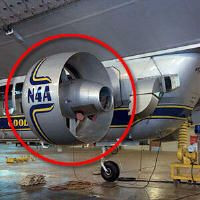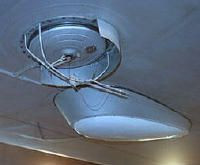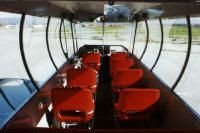How High Can A Blimp Fly? Typically, a blimp can fly up to an altitude of 10,000 feet, but this is affected by several factors. At flyermedia.net, we will explore the different aspects that determine the operational altitude of a blimp, considering weather conditions, air pressure, and design limitations. This knowledge is essential for aviation enthusiasts and professionals alike, providing insights into blimp altitude, lighter-than-air craft operation, aviation safety, and flight regulations.
1. What Factors Determine the Maximum Altitude of a Blimp?
Several factors determine how high a blimp can fly, including envelope capacity, atmospheric pressure, regulatory restrictions, and operational requirements.
-
Helium Capacity: The volume of helium a blimp’s envelope can hold is a primary factor. Larger envelopes can generate more lift, allowing the blimp to reach higher altitudes.
-
Atmospheric Pressure: As altitude increases, atmospheric pressure decreases. This causes the helium inside the blimp’s envelope to expand. If the envelope cannot accommodate this expansion, it could rupture.
-
Regulatory Restrictions: Aviation authorities, like the FAA (Federal Aviation Administration) in the United States, impose altitude restrictions for blimps to ensure aviation safety and prevent conflicts with other air traffic.
-
Operational Requirements: The intended use of the blimp also dictates its operational altitude. For instance, blimps used for aerial advertising might fly at lower altitudes to maximize visibility.
2. How Does the Design of a Blimp Affect Its Maximum Altitude?
The design of a blimp significantly affects its maximum altitude, influencing its aerodynamic properties, structural integrity, and overall performance.
-
Envelope Material: The material used for the blimp’s envelope must be lightweight yet durable enough to withstand pressure differences at high altitudes.
-
Shape and Aerodynamics: The blimp’s shape is optimized for aerodynamic efficiency to reduce drag, allowing it to ascend more easily and maintain stability at higher altitudes.
-
Internal Structures: Components like ballonets (air-filled bags inside the envelope) help manage pressure and maintain the blimp’s shape as it ascends or descends.
-
Engine and Propulsion Systems: The efficiency and power of the engines determine how well the blimp can climb and maintain altitude.
3. What are the Regulatory Altitude Restrictions for Blimps?
Regulatory altitude restrictions for blimps are imposed by aviation authorities like the FAA to ensure safety and prevent conflicts with other air traffic.
- FAA Regulations: The FAA sets specific altitude limits for blimps based on their class and intended operation. These regulations ensure that blimps operate safely within the national airspace system.
- Controlled Airspace: Blimps operating in controlled airspace (e.g., near airports) must adhere to strict altitude restrictions to avoid interfering with commercial air traffic.
- Minimum Safe Altitudes: Regulations also specify minimum safe altitudes for blimps, ensuring they maintain sufficient clearance from the ground and obstacles.
- Temporary Flight Restrictions (TFRs): During special events or emergencies, temporary flight restrictions may be imposed, further limiting the altitudes at which blimps can operate.
4. How Does Weather Impact a Blimp’s Flight Altitude?
Weather conditions significantly affect a blimp’s flight altitude, influencing its stability, lift, and overall performance.
- Temperature: Temperature affects the density of the helium inside the envelope. Higher temperatures can cause the helium to expand, increasing lift, while lower temperatures can reduce lift.
- Wind: Strong winds can destabilize a blimp, making it difficult to control at higher altitudes. Pilots must consider wind speed and direction when planning their flight.
- Atmospheric Pressure: Changes in atmospheric pressure, due to weather systems, can affect the blimp’s buoyancy and altitude.
- Precipitation: Rain or snow can add weight to the blimp, reducing its maximum achievable altitude.
5. What is the Typical Operating Altitude for Commercial Blimps?
The typical operating altitude for commercial blimps varies depending on their intended use, but generally falls within a range that balances visibility, regulatory compliance, and operational efficiency.
- Advertising Blimps: These often fly at lower altitudes (1,000 to 3,000 feet) to maximize visibility of their advertisements to ground-based audiences.
- Surveillance Blimps: Depending on the surveillance technology and objectives, these might operate at mid-range altitudes (3,000 to 6,000 feet) to provide a broad view without being easily detectable.
- Research Blimps: These can operate at higher altitudes (up to 10,000 feet or more) to conduct atmospheric research or other scientific studies.
- Tourism Blimps: Aiming for scenic views, these usually fly at moderate altitudes (2,000 to 5,000 feet) to provide a balance between altitude and proximity to landmarks.
6. What Safety Measures are in Place to Prevent Blimps from Exceeding Safe Altitudes?
Several safety measures prevent blimps from exceeding safe altitudes, ensuring the well-being of both the crew and the public.
-
Altitude Monitoring Systems: Modern blimps are equipped with sophisticated altitude monitoring systems that provide real-time data to the pilot.
-
Pressure Relief Valves: These valves automatically release helium if the internal pressure exceeds safe limits, preventing the envelope from rupturing at high altitudes.
-
Pilot Training: Blimp pilots undergo rigorous training to understand the effects of altitude on the blimp and how to manage its ascent and descent safely.
-
Regulatory Oversight: Aviation authorities continuously monitor blimp operations and enforce altitude restrictions through inspections and penalties for non-compliance.
7. How Do Ballonets Help Control Altitude in a Blimp?
Ballonets are internal air-filled bags that help control altitude in a blimp by managing the volume of air inside the envelope.
-
Maintaining Pressure: Ballonets maintain the shape and pressure of the blimp’s envelope as it ascends and descends. As the blimp rises, the helium expands, and ballonets deflate to accommodate this expansion.
-
Adjusting Buoyancy: By inflating or deflating the ballonets, pilots can adjust the blimp’s buoyancy. Inflating the ballonets adds weight, causing the blimp to descend, while deflating them reduces weight, allowing the blimp to ascend.
-
Trim Control: Ballonets also help control the trim, or levelness, of the blimp, ensuring it remains stable during flight.
-
Responding to Temperature Changes: Ballonets compensate for temperature-induced changes in the helium’s volume, maintaining consistent lift.
8. What are the Effects of High Altitude on Blimp Performance?
High altitude significantly affects blimp performance, impacting lift, engine efficiency, and overall maneuverability.
-
Reduced Lift: As altitude increases, air density decreases, reducing the amount of lift generated by the helium.
-
Engine Efficiency: Engines may experience reduced efficiency at high altitudes due to the thinner air, requiring adjustments to maintain optimal performance.
-
Increased Drag: The shape and design of the blimp must account for the changes in drag at different altitudes, affecting its speed and fuel efficiency.
-
Temperature Extremes: High altitudes can expose the blimp to extreme temperatures, which can affect the envelope material and the performance of onboard systems.
9. How Does the Size of a Blimp Affect Its Maximum Altitude?
The size of a blimp is a crucial factor affecting its maximum altitude, directly influencing its lift capacity and overall performance.
-
Larger Envelope: A larger envelope can hold more helium, generating greater lift. This allows the blimp to carry more weight and reach higher altitudes.
-
Surface Area: The increased surface area of a larger blimp can also affect its drag and stability, particularly in windy conditions.
-
Structural Integrity: Larger blimps require stronger structural components to withstand the increased stresses at high altitudes.
-
Operational Costs: The operational costs associated with larger blimps are higher due to increased helium requirements and maintenance needs.
10. Can Blimps Fly Higher Than Airplanes?
While blimps can reach considerable altitudes, they generally cannot fly as high as airplanes due to fundamental differences in design and propulsion.
-
Altitude Ceiling: Airplanes, especially commercial jets, can fly at altitudes of 30,000 to 40,000 feet, while blimps typically have a maximum altitude of around 10,000 feet.
-
Lift Generation: Airplanes generate lift through the dynamic airflow over their wings, which is more efficient at higher speeds and altitudes. Blimps rely on the static lift provided by helium, which decreases with altitude.
-
Engine Performance: Airplane engines are designed to operate efficiently at high altitudes, while blimp engines are optimized for lower altitudes.
-
Structural Limitations: The structural limitations of blimp envelopes prevent them from withstanding the pressure differences encountered at airplane altitudes.
11. How Does Atmospheric Pressure Affect a Blimp’s Maximum Flight Altitude?
Atmospheric pressure significantly impacts a blimp’s maximum flight altitude due to the relationship between pressure and the volume of helium within the envelope.
- Pressure Decrease: As a blimp ascends, atmospheric pressure decreases. This causes the helium inside the blimp’s envelope to expand.
- Envelope Expansion: The envelope must be able to accommodate the expanding helium without rupturing. If the envelope reaches its maximum volume, the blimp can no longer ascend safely.
- Ballonet Adjustment: Ballonets inside the envelope help manage this expansion by deflating as the blimp rises. However, there is a limit to how much the ballonets can compensate.
- Altitude Limit: The altitude at which the envelope can no longer safely accommodate the expanding helium becomes the blimp’s maximum flight altitude.
12. What is the Role of Helium in Determining How High a Blimp Can Fly?
Helium plays a critical role in determining how high a blimp can fly, as it provides the necessary lift for the blimp to ascend and maintain altitude.
- Lifting Gas: Helium is a lighter-than-air gas that provides buoyancy to the blimp. The amount of lift generated is directly proportional to the volume of helium in the envelope.
- Altitude and Lift: As the blimp rises, the atmospheric pressure decreases, causing the helium to expand. This expansion can increase lift, but it also puts stress on the envelope.
- Helium Purity: The purity of the helium also affects lift. Higher purity helium provides greater lift compared to helium mixed with air.
- Temperature Sensitivity: Helium is sensitive to temperature changes, which can affect its density and lift. Pilots must account for these changes during flight.
13. What Types of Blimps Can Reach the Highest Altitudes?
Certain types of blimps are designed to reach higher altitudes than others, depending on their construction, envelope capacity, and intended use.
- High-Altitude Research Blimps: These blimps are specifically designed for scientific research and can reach altitudes of up to 70,000 feet.
- Surveillance Blimps: Some surveillance blimps are designed to operate at high altitudes to provide a wide area of coverage.
- Airships: Although technically different from blimps (airships have a rigid internal structure), they can sometimes reach higher altitudes due to their robust design.
- Experimental Blimps: Experimental blimps with advanced materials and designs are continually being developed to push the boundaries of altitude capabilities.
14. How Do Air Scoops and Air Valves Affect Altitude Control in Blimps?
Air scoops and air valves are essential components for altitude control in blimps, allowing pilots to manage the air volume within the ballonets and maintain stable flight.
- Air Scoops: Air scoops are used to direct air into the ballonets. Pilots can open or close the air scoops to control the amount of air entering the ballonets, thereby adjusting the blimp’s buoyancy.
- Air Valves: Air valves are used to vent air from the ballonets. By opening the air valves, pilots can release air, reducing the blimp’s buoyancy and causing it to descend.
- Dynamic Altitude Control: The combined use of air scoops and air valves allows for dynamic altitude control, enabling pilots to make precise adjustments during flight.
- Maintaining Equilibrium: These systems help maintain equilibrium by compensating for changes in temperature, atmospheric pressure, and helium volume.
 Nose cone battens provide aerodynamic support
Nose cone battens provide aerodynamic support
15. What Role Do Flight Control Surfaces Play in Managing Blimp Altitude?
Flight control surfaces, such as rudders and elevators, play a vital role in managing blimp altitude by allowing pilots to control the pitch and yaw of the aircraft.
- Elevators: Elevators control the pitch of the blimp, determining whether it ascends or descends. By adjusting the elevators, pilots can change the angle of attack and manage altitude.
- Rudders: Rudders control the yaw of the blimp, allowing pilots to steer left or right. While rudders primarily manage horizontal movement, they can also indirectly affect altitude by influencing the blimp’s overall stability.
- Coordination: Effective altitude management requires coordination between the flight control surfaces and the ballonet system.
- Stability: Properly adjusted flight control surfaces enhance the blimp’s stability, making it easier to maintain a desired altitude.
16. How is Pilot Training Related to Understanding Blimp Altitude Limits?
Pilot training is crucial for understanding blimp altitude limits and ensuring safe and efficient operation of these unique aircraft.
- Theoretical Knowledge: Pilots receive extensive theoretical training on the principles of flight, including the effects of altitude on blimp performance.
- Practical Experience: Training includes hands-on experience in managing altitude through the use of ballonets, air scoops, and flight control surfaces.
- Emergency Procedures: Pilots are trained to handle emergency situations, such as rapid ascents or descents, and to respond effectively to changes in atmospheric conditions.
- Regulatory Compliance: Training ensures that pilots are fully aware of and compliant with all regulatory altitude restrictions.
17. What Technologies are Used to Monitor and Control a Blimp’s Altitude?
Modern blimps utilize a range of advanced technologies to monitor and control altitude, ensuring safe and efficient operation.
- Altimeters: Altimeters provide real-time altitude readings, allowing pilots to maintain the desired flight level.
- GPS Systems: GPS systems provide precise location and altitude data, enhancing navigational accuracy.
- Pressure Sensors: Pressure sensors monitor the internal and external pressure, ensuring the envelope remains within safe limits.
- Automated Control Systems: Some blimps are equipped with automated control systems that assist in managing altitude by automatically adjusting ballonets and flight control surfaces.
18. How Do Blimp Engines Influence Their Ability to Reach and Maintain Altitude?
Blimp engines play a significant role in their ability to reach and maintain altitude by providing the necessary thrust for ascent and controlling vertical movement.
- Thrust Generation: Engines generate thrust, which propels the blimp forward and can be directed upwards to assist in climbing.
- Altitude Maintenance: By adjusting the engine power, pilots can maintain a stable altitude and compensate for changes in buoyancy.
- Engine Efficiency: Efficient engines consume less fuel, allowing the blimp to stay aloft longer and reach higher altitudes.
- Vertical Control: The engines, in conjunction with the flight control surfaces and ballonet system, provide precise vertical control.
 Goodyear air valve
Goodyear air valve
19. What is the Relationship Between Blimp Weight and Maximum Altitude?
The weight of a blimp is directly related to its maximum altitude, as the blimp must generate enough lift to overcome its weight and ascend.
- Lift Capacity: The amount of lift a blimp can generate is determined by the volume of helium in its envelope. This lift must exceed the blimp’s total weight for it to fly.
- Weight Reduction: Reducing the blimp’s weight allows it to reach higher altitudes. This can be achieved through the use of lightweight materials and efficient design.
- Payload Considerations: The weight of the payload (passengers, equipment, etc.) also affects the blimp’s maximum altitude.
- Optimal Balance: Achieving an optimal balance between weight and lift is crucial for maximizing altitude performance.
20. What Happens if a Blimp Exceeds Its Maximum Safe Altitude?
Exceeding a blimp’s maximum safe altitude can have serious consequences, potentially endangering the aircraft and its occupants.
- Envelope Rupture: The most significant risk is the potential for the envelope to rupture due to the expanding helium exceeding the material’s limits.
- Loss of Control: As altitude increases, the blimp becomes more difficult to control due to the decreasing air density and changing aerodynamic forces.
- Equipment Malfunction: High altitudes can cause onboard equipment to malfunction, further complicating the situation.
- Emergency Descent: Pilots may be forced to initiate an emergency descent, which can be hazardous if not executed properly.
21. How Do Different Atmospheric Conditions Affect a Blimp’s Ascent Rate?
Atmospheric conditions such as temperature, humidity, and wind play a critical role in influencing a blimp’s ascent rate.
- Temperature Gradients: Warm air rises, so if the temperature inside the blimp’s envelope is warmer than the surrounding air, the ascent rate will increase. Conversely, cooler air will decrease the ascent rate.
- Humidity Levels: High humidity can add weight to the blimp as moisture condenses on its surface, slowing down the ascent.
- Wind Resistance: Strong headwinds can impede the blimp’s forward and upward motion, reducing the ascent rate. Tailwinds, on the other hand, can aid in a faster ascent.
- Pressure Systems: Changes in atmospheric pressure can affect the blimp’s buoyancy. Low-pressure systems may enhance the ascent rate, while high-pressure systems may reduce it.
22. What are the Key Differences in Altitude Capabilities Between Blimps and Airships?
Blimps and airships, though similar, have key differences in their altitude capabilities due to their distinct structural designs.
- Structural Rigidity: Airships have a rigid internal structure, allowing them to maintain their shape and integrity at higher altitudes where pressure differences are more extreme. Blimps, being non-rigid, are more susceptible to deformation and altitude limitations.
- Maximum Altitude Range: Airships can typically reach higher altitudes than blimps, with some models capable of ascending to 10,000 feet or more, while blimps generally operate below this level.
- Envelope Material: Airships often use more robust envelope materials that can withstand greater pressure differentials, enabling them to fly higher.
- Operational Considerations: Blimps are often used for lower-altitude applications like advertising and surveillance, while airships might be employed for tasks requiring higher altitudes and longer endurance.
23. How do Modern Blimp Designs Accommodate Altitude-Related Stress on the Envelope?
Modern blimp designs incorporate several features to mitigate altitude-related stress on the envelope, ensuring safe and efficient operation.
- Advanced Materials: Modern blimps use high-strength, lightweight materials that can withstand significant pressure differences without tearing or deforming.
- Ballonet Systems: Ballonets, internal air-filled compartments, help manage pressure inside the envelope by inflating or deflating to compensate for changes in altitude.
- Pressure Relief Valves: These valves automatically release helium if the internal pressure exceeds safe limits, preventing over-pressurization and potential rupture.
- Reinforced Seams: Seams are reinforced to provide additional strength and prevent tearing, especially at high-stress points on the envelope.
24. What Innovations Could Potentially Increase the Maximum Altitude of Future Blimps?
Future blimp designs could incorporate several innovations to potentially increase their maximum achievable altitude.
- Advanced Materials: Development of new, lighter, and stronger envelope materials could allow blimps to withstand greater pressure differences at higher altitudes.
- Variable Volume Envelopes: Envelopes that can dynamically adjust their volume could better manage pressure changes and allow for higher ascents.
- Hybrid Propulsion Systems: Combining traditional engines with electric or solar-powered systems could improve efficiency and allow for sustained flight at higher altitudes.
- Autonomous Control Systems: Advanced control systems that automatically adjust ballonet pressure, engine output, and flight surfaces could enhance stability and safety at higher altitudes.
25. How Does Air Density at Different Altitudes Impact the Maneuverability of a Blimp?
Air density significantly impacts the maneuverability of a blimp, as the effectiveness of control surfaces and engines decreases with altitude.
- Reduced Lift: At higher altitudes, the air is less dense, which reduces the amount of lift generated by the helium. This makes it more difficult for the blimp to ascend and maintain altitude.
- Engine Performance: The efficiency of the engines also decreases with altitude due to the thinner air, reducing the available thrust for maneuvering.
- Control Surface Effectiveness: Control surfaces, such as rudders and elevators, are less effective in thinner air, requiring greater deflection to achieve the same degree of control.
- Response Time: The response time of the blimp to control inputs is slower at higher altitudes due to the reduced aerodynamic forces.
26. How do Fore and Aft Ballonets contribute to Altitude Management in Blimps?
Fore and aft ballonets play a vital role in altitude management by allowing precise control over the blimp’s pitch and buoyancy.
- Pitch Control: By adjusting the air volume in the fore and aft ballonets, pilots can control the pitch of the blimp, determining whether it ascends or descends.
- Buoyancy Adjustment: Simultaneously adjusting both ballonets allows for changes in overall buoyancy without significantly affecting the pitch, enabling level flight at different altitudes.
- Trim Stabilization: Ballonets help maintain trim by compensating for shifts in weight distribution or changes in aerodynamic forces.
- Altitude Precision: Precise adjustments to the ballonets enable fine-tuned altitude control, critical for tasks such as surveillance and aerial photography.
27. What are Some Real-World Examples of Blimps Operating at or Near Their Maximum Altitudes?
While specific operational details are often proprietary, there are examples of blimps undertaking missions near their maximum altitudes.
- Scientific Research: High-altitude research blimps are used to study atmospheric conditions, collect data on air quality, and conduct astronomical observations. These missions often require operating at or near the blimp’s maximum altitude to reach specific atmospheric layers.
- Military Surveillance: Some military blimps are designed to operate at high altitudes for extended periods to provide wide-area surveillance and reconnaissance. These missions demand precise altitude control to maintain optimal sensor coverage.
- Telecommunications Relay: Blimps have been used as aerial platforms to relay telecommunications signals, requiring them to operate at altitudes that provide optimal coverage and signal strength.
- Disaster Response: In disaster response scenarios, blimps equipped with communication equipment and sensors may operate at high altitudes to assess damage and coordinate relief efforts.
 Blimp gondola showcasing pilot seats and passenger seating
Blimp gondola showcasing pilot seats and passenger seating
28. Can a Blimp Rapidly Descend from High Altitude in Case of Emergency?
Blimps are equipped with systems that allow for a controlled, but not necessarily rapid, descent from high altitudes in case of emergency.
- Air Valves: Pilots can rapidly vent air from the ballonets, reducing buoyancy and initiating a descent.
- Elevators: Adjusting the elevators can increase the rate of descent by changing the blimp’s pitch.
- Helium Release Valve: In extreme emergencies, pilots can release helium from the envelope to initiate a faster descent, although this is typically a last resort due to the loss of lift.
- Parachute Systems: Some blimps are equipped with parachute systems that can be deployed to slow the descent and provide a safer landing.
29. How Does the Shape of a Blimp Contribute to Its Altitude Performance?
The shape of a blimp is carefully designed to optimize its altitude performance by minimizing drag and maximizing lift.
- Aerodynamic Profile: The streamlined, cigar-shaped envelope reduces drag, allowing the blimp to ascend more easily and maintain speed at higher altitudes.
- Surface Area Optimization: The shape is designed to maximize surface area for lift generation while minimizing surface area for drag.
- Stability Enhancement: The shape contributes to the blimp’s overall stability, making it easier to control and maintain altitude.
- Pressure Distribution: The shape helps distribute pressure evenly across the envelope, reducing stress and preventing deformation at high altitudes.
30. What Are the Long-Term Implications of High-Altitude Blimp Operations for Atmospheric Research?
High-altitude blimp operations offer significant long-term implications for atmospheric research by providing cost-effective and versatile platforms for data collection.
- Continuous Monitoring: Blimps can remain aloft for extended periods, providing continuous monitoring of atmospheric conditions.
- Versatile Payload Capacity: Blimps can carry a variety of scientific instruments, allowing for comprehensive data collection on temperature, humidity, air quality, and other parameters.
- Targeted Data Collection: Blimps can be maneuvered to specific locations and altitudes, enabling targeted data collection on specific atmospheric phenomena.
- Cost-Effectiveness: Compared to satellites and airplanes, blimps offer a more cost-effective platform for long-term atmospheric research.
Ready to discover more about the world of aviation? Visit flyermedia.net today to explore our comprehensive resources, from pilot training programs to the latest aviation news and career opportunities. Your journey into the skies starts here!
Address: 600 S Clyde Morris Blvd, Daytona Beach, FL 32114, United States
Phone: +1 (386) 226-6000
Website: flyermedia.net
FAQ: Frequently Asked Questions About Blimp Altitude
1. What is the highest altitude a blimp has ever flown?
The highest altitude a blimp has ever flown is approximately 70,000 feet, achieved by specialized high-altitude research blimps.
2. Can weather conditions prevent a blimp from reaching its maximum altitude?
Yes, adverse weather conditions such as strong winds, temperature extremes, and precipitation can significantly limit a blimp’s ability to reach its maximum altitude.
3. How do blimp pilots manage altitude changes during flight?
Blimp pilots manage altitude changes by adjusting the air volume in the ballonets, using air scoops and air valves, and coordinating with the flight control surfaces.
4. What safety equipment is required for blimps flying at high altitudes?
Safety equipment for high-altitude blimps includes altitude monitoring systems, pressure relief valves, oxygen systems, and emergency descent mechanisms.
5. Are there different regulations for blimps flying at different altitudes?
Yes, aviation authorities impose different regulations for blimps based on their operating altitude to ensure safety and prevent conflicts with other air traffic.
6. How does the weight of a blimp’s payload affect its maximum altitude?
A heavier payload reduces the blimp’s maximum altitude because the blimp must generate enough lift to overcome its total weight.
7. What training do blimp pilots receive regarding altitude management?
Blimp pilots receive extensive training on the principles of flight, the effects of altitude on blimp performance, and how to manage altitude through various control systems.
8. How do changes in atmospheric pressure affect a blimp’s altitude?
As a blimp ascends, atmospheric pressure decreases, causing the helium inside the envelope to expand, which affects the blimp’s buoyancy and altitude.
9. Can blimps fly at night, and does this affect their altitude capabilities?
Yes, blimps can fly at night, but pilots must consider temperature changes and visibility, which can indirectly affect their altitude capabilities.
10. What innovations are being developed to improve blimp altitude performance?
Innovations include advanced materials, variable volume envelopes, hybrid propulsion systems, and automated control systems designed to enhance stability and safety at higher altitudes.

